
Among Soviet Jews, there has always been a significant number of individuals who dreamt of repatriating to Israel. The post-war Soviet era saw societal anti-Semitism, which was further exacerbated by state-sponsored discrimination. This situation fueled the desire of Jews to leave the Soviet Union. The Six-Day War, in which Israel emerged victorious against Arab countries, sparked a wave of national self-awareness among Jews worldwide, including those in the Soviet Union. However, the majority of requests for emigration to Israel were denied, leading to the emergence of a growing group called "refuseniks." Refuseniks were individuals who were denied exit permits, which resulted in them facing difficulties in pursuing their professions and experiencing dire financial circumstances. Many of them found themselves driven to despair. In response, these refuseniks wrote petitions and open letters to the authorities, both individually and collectively, highlighting their family's problems and requesting permission to leave. They also protested against the violation of their right to emigrate, the national discrimination against Jews, and the anti-Semitic campaigns in Soviet media. Within this context, the arrest of twelve individuals in the summer of 1970, who were planning to hijack an airplane from Leningrad to Priozersk, should be understood. It is important to note that the majority of these "aircraft hijackers" had been unsuccessful in obtaining permission to emigrate to Israel. The trial of the "aircraft hijackers" took place in December 1970. The defendants claimed that they had no intention of harming the pilot; their plan was to hijack the aircraft and fly it to Sweden or Finland. The conspirators possessed only one inoperative gun, which they intended to use for intimidation. Among those involved was a pilot named Mark Dymshits, who was supposed to fly the plane abroad. The "aircraft hijackers" denied any anti-Soviet intent, stating that their sole desire was to escape to Israel. However, the verdict was extremely harsh: Mark Dymshits and Eduard Kuznetsov were sentenced to death, while the others received sentences ranging from 8 to 15 years of imprisonment. The severity of the punishments, particularly the death sentences, shocked many and further highlighted the desperate situation faced by Soviet Jews seeking repatriation to Israel. In response to the international outcry, the Soviet government was compelled to revise the sentences. The appellate court commuted the death sentences to 15-year prison terms and reduced the sentences of several other convicts.
Subsequently, 22 more participants of the Jewish movement were arrested in Leningrad, Kishinev, and Riga, despite not being involved in the attempted hijacking. This led to a wave of searches in various cities, including over 40 searches in Leningrad alone, targeting Jewish samizdat (underground literature), tamizdat (foreign-published literature), and Hebrew textbooks. During the summer of 1971, trials known as the "near-aircraft" processes took place in Riga, Leningrad, and Kishinev. In the Leningrad trial, two defendants were charged with "betrayal of the motherland" due to their alleged involvement with the organizers of an aircraft hijacking, receiving sentences of 10 and 7 years in labor camps. The rest of the defendants were accused of disseminating Jewish samizdat and seeking Jewish self-education. The charges against them resulted in sentences ranging from 1 to 5 years in labor camps. Parallel to these trials, other individuals faced legal proceedings. Reiza Palatnik was tried in Odessa, Valery Kukuy in Sverdlovsk, and Igor Golts in Lutsk during the same period of 1970-1971. Emilia Trakhtenberg in Samarkand (1971) and Yakov Khantsis in Kishinev (1972) also faced similar trials on charges of "slandering the Soviet system." The condemnation of those wishing to repatriate to Israel sparked protests in many countries, particularly in the USA and Israel. Numerous demonstrations were held, and fundraising efforts were organized in support of the refuseniks.
These events are reflected in the objects of phaleristics and numismatics. Coins [1], medals [2, 3] and many badges [4 – 6] were issued dedicated to the struggle for the freedom of prisoners of conscience and the right of Soviet Jews to leave the USSR for Israel. The focus of this article is on the medallions (pendants) included in the Prisoner of Conscience kits (Fig.1). These kits were created in the 1970s by the Cleveland Council on Soviet Anti-Semitism (CCSA) in collaboration with the Union of Councils for Soviet Jews (UCSJ) [7]. Each set was dedicated to a specific Jewish prisoner of conscience in the Soviet Union and consisted of two information cards and one medallion. The medallions in the shape of a six-pointed star depict a Star of David chained to a lock with the symbol of the Soviet Union and the inscription "Let my people go" in English and Hebrew. The reverse side of the medallion featured the name of the Refusenik on a raised "plaque" above the inscription "USSR Prisoner of Conscience." The medallions were made in silver and gold colors, weighing 24.5 grams.

Fig. 1 (Photo from [7])
Medallions appeared in early 1973. The Council on Soviet Jews issued them. The idea of issuing medallions and their design belongs to one of the leaders of the Council, Si Frumkin. Here is how Louis Rosenblum, an activist in support of Soviet Jews, describes it in his memoirs [8]: “Si Frumkin came up with this idea and the design — a Magen David medallion, necklaces, each bearing the name of a different prisoner of conscience. And he found a company to fabricate them. It was a real hit. And, it also produced income for the councils because the medallions were produced fairly inexpensively and could be sold for a buck or a buck-and-a-half apiece. Later, Si had bracelets made in a similar design.”
This article can be considered the first attempt to create a catalog of these medallions. The author has never been able to find a list of prisoners of conscience whose names the medallions were issued with. A long search on the Internet made it possible to compile the following list of people to whom the medallions were dedicated: Anatoly Altman, Boris Azernikov, Yuri Brind, Hillel Butman, Shlomo Drezner, Mark Dymshits, Anatoly Goldfeld, Lassalle Kaminsky, Leib Khnokh, Mikhail Kornblit, Valeri Kukui, Eduard Kuznetsov, Semyon Levit, Iosif Mendelevich, Rayza Palatnik, Boris Penson, Yuri Vudka, Israel (Izia) Zalmanson, Sylva Zalmanson, and Wolf Zalmanson. Below are photographs of medallions from the author's collection as well as those found on various Internet sites. Apparently, this list cannot claim to be complete. The author would be grateful to readers who could tell him which other prisoners of conscience medallions were dedicated to as well as any information about medals and badges dedicated to the struggle for the repatriation of Soviet Jews.

|

|
| Fig. 2 | Fig. 2a |
Anatoly Altman
Attempted hijacking of an airplane from Leningrad 1970.
Fig. 2, 2a

|

|
| Fig. 3 | Fig. 3a |
Boris Azernikov was arrested in August 1971 and sentenced to 3.5 years in labor camps on charges of anti-Soviet agitation and propaganda. The real reason for his persecution seems to be that he acted as a witness in one of the political trials, where he refused to testify against his friends. After applying for emigration to Israel, he was arrested.

|

|
| Fig. 4 | Fig. 4a |
Yuri Brind
On January 13th 1972 he applied for an exit visa. On February 1st his apartment was searched. He was arrested and taken to a hospital for the mentally ill. On April 5th he was found fit to stand trial and charged with anti-Soviet fabrications and slander.
Fig. 4, 4a

|

|
| Fig. 5 | Fig. 5a |
Hillel Butman
Participation in an illegal Zionist organization. The author are aware of a silver-colored (Fig. 5) and gold-colored (Fig. 5a) medallions with the Butman family name.

|

|
| Fig. 6 | Fig. 6a |
Shlomo Drezner
He was a member of the pro-Israel underground in Leningrad. Arrested in 1970 and sentenced to three years at a camp.
Fig. 6, 6a

|

|
| Fig. 7 | Fig. 7a |
Mark Dymshits
Attempted hijacking of an airplane from Leningrad 1970. Death sentence commuted to 15 years in a camp.
Fig. 7, 7a
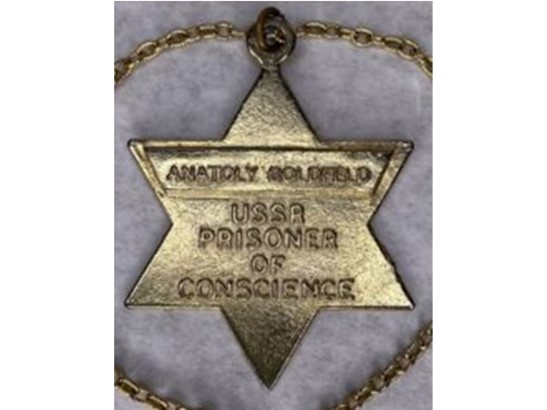
|

|
| Fig. 8 | Fig. 8a |
Anatoly Goldfeld
Participation in an illegal Zionist organization.
Fig. 8, 8a

|

|
| Fig. 9 | Fig. 9a |
Lassalle Kaminsky
In 1968 he became a member of the underground Zionist organization in Leningrad, studied Hebrew, the history of the Jewish people and Israel. On June 15, 1970, he was arrested on charges of Zionist activity and a desire to immigrate to Israel. In 1971 (2nd Leningrad trial) he was sentenced to 5 years in prison, which he served in camps.
The author are aware of a silver-colored (Fig. 9) and gold-colored (Fig. 9a) medallions with the Kaminsky family
Fig. 9, 9a

|

|
| Fig. 10 | Fig. 10a |
Leib Khnokh
Attempted hijacking of an airplane from Leningrad 1970.
The author are aware of a silver-colored (Fig. 10) and gold-colored (Fig. 10a) medallions with the Khnоkh family name.
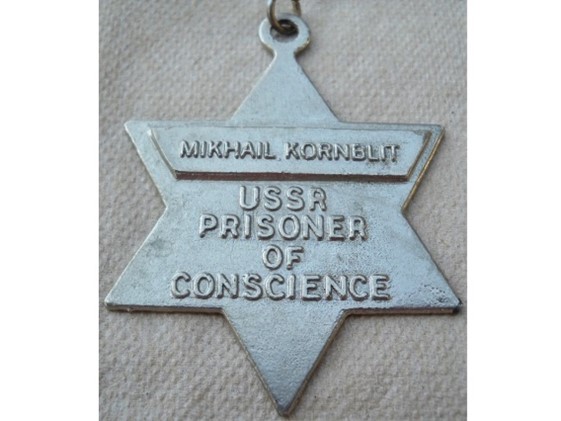
|

|
| Fig. 11 | Fig. 11a |
Mikhail Kornblit
Participation in an illegal Zionist organization.
The author are aware of a silver-colored (Fig. 11) and gold-colored (Fig. 11a) medallions with the Kornblit family name.

|

|
| Fig. 12 | Fig. 12a |
Valeri Kukui
He was a Jewish activist in Russia sentenced in 1971 to three years in a Soviet Labor Camp.
The author are aware of a silver-colored (Fig. 12) and gold-colored (Fig. 12a) medallions with the Kukui family name.
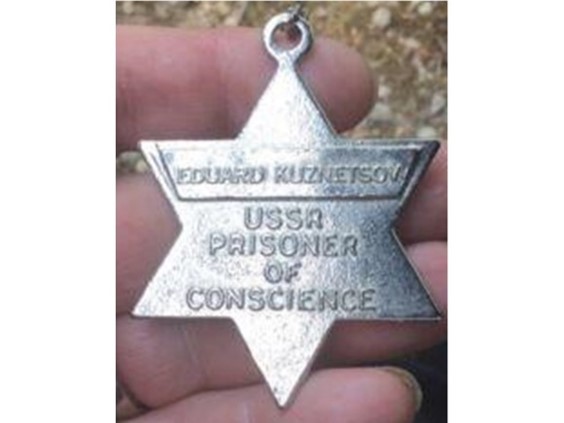
|

|
| Fig. 13 | Fig. 13a |
Eduard Kuznetsov
Attempted hijacking of an airplane from Leningrad 1970. Death sentence commuted to 15 years in a camp.
Fig. 13, 13a

|

|
| Fig. 14 | Fig. 14a |
Semion Levit
He studied in Leningrad, where he joined an underground Zionist group to study Hebrew, Jewish history and culture, and the history of Zionism. Arrested in 1970, tried at the end of 1971 at the Kishinev trial. Sentenced to 2 years in a Mordovian camp, after 1.5 years he was released. In 1973 he immigrated to Israel.
Fig. 14, 14a

|

|
| Fig. 15 | Fig. 15a |
Vladimir Markman
He was a Jewish activist who applied for a visa to Israel/ He was sentenced in 1972 in Sverdlovsk to three years in a Soviet Labor Camp.
Fig. 15, 15a

|

|
| Fig. 16 | Fig. 16a |
Iosif Mendelevich (on the medallion: Mendelovich)
Attempted hijacking of an airplane from Leningrad 1970.
Fig. 16, 16a

|

|
| Fig. 17 | Fig. 17a |
Rayza Palatnik
Arrested in 1970 on charges of Zionist activity, she was sentenced to 2 years in prison.
The author are aware of a silver-colored (Fig. 17) and gold-colored (Fig. 17a) medallions with the Palatnik family name.

|

|
| Fig. 18 | Fig. 18a |
Boris Penson
Attempted hijacking of an airplane from Leningrad 1970.
The author are aware of a silver-colored (Fig. 18) and gold-colored (Fig. 18a) medallions with the Penson family name.
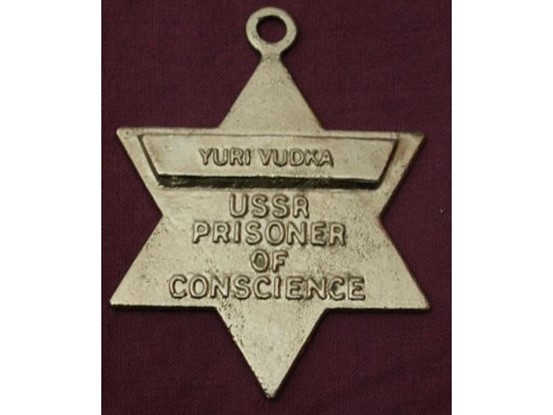
|

|
| Fig. 19 | Fig. 19a |
Yuri Vudka
Arrested in 1969 on charges of anti-state and Zionist activities and sentenced in 1970 to 7 years in strict regime camps.
Fig. 19, 19a

|

|
| Fig. 20 | Fig. 20a |
Israel (Izia) Zalmanson
Attempted hijacking of an airplane from Leningrad 1970.
The author are aware of a silver-colored (Fig. 20) and gold-colored (Fig. 20a) medallions with the Izia Zalmanson name.
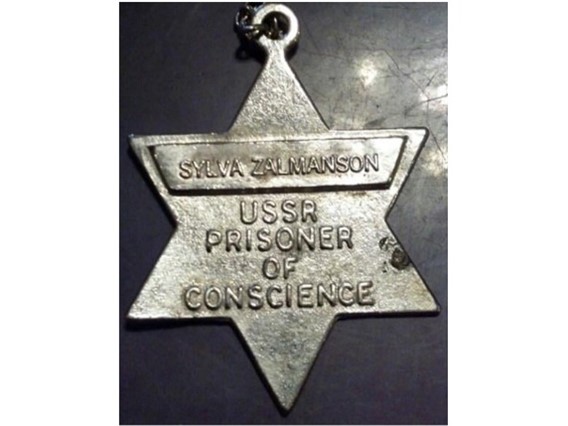
|

|
| Fig. 21 | Fig. 21a |
Sylva Zalmanson
Attempted hijacking of an airplane from Leningrad 1970. Sentenced to 10 years of imprisonment.
The author are aware of a silver-colored (Fig. 21) and gold-colored (Fig. 21a) medallions with the Silva Zalmanson name.

|

|
| Fig. 22 | Fig. 22a |
Wolf Zalmanson
Attempted hijacking of an airplane from Leningrad 1970.
Fig. 22, 22a
Literature:
1. Let My People Go (Coin Announced) “The SHEKEL” Volume IV, No. 3, p. 14, 1971.
2. Former Leningrad Mint Artist Creates Shcharansky "Prisoner of Conscience" Medal, “The SHEKEL” Volume XVI, No. 5, p. 28 - 29, 1983.
3. Jack H Fisher, Soviet Jewish Human Rights Activists Awarded US- Congressional Go1d Medals “The SHEKEL” Volume XXII No. 2, p. 25 - 27, 1989.
4. V. Bernshtam, “Medallions “Let my people go” Numismatics and Faleristics, №3, p. 24 – 26, 2017. В. Бернштам, “Медальоны “Отпусти народ мой” Нумизматика и Фалеристика, №3, с. 24 – 26, 2017.
5. M. Beiser, V. Bernshtam, Badges of the Center for Information on Soviet Jewry, Numismatics and Faleristics, №2, p. 37, 2021. (in Russian) М. Бейзер, В. Бернштам, Значки Центра информации о советском еврействе, Нумизматика и Фалеристика, №2, с. 37, 2021.
6. M. Beizer, V. Bernshtam, Badges of the organization "Struggle of students for Soviet Jews", Numismatics and Faleristics, №3, p. 32 – 34, 2021. (in Russian) М. Бейзер, В. Бернштам, Значки организации «Борьба студентов за советских евреев», Нумизматика и Фалеристика, №3, с. 32 – 34, 2021.
7. Teacher Guide 7th – 11th Grade “Are we Responsible for Others? The Movement to Free Soviet Jews”, National museum of American Jewish History, https://info.nmajh.org/uploadedFiles/Education/SovietJewry_TeacherGuide%20FNL%281%29.pdf
8. Involvement in the Soviet Jewry Movement A Personal Account, 1961-1978, Interviews with Louis Rosenblum by Daniel Rosenblum, http://www.clevelandjewishhistory.net/sj/interview.pdf